Harris C.M., Piersol A.G. Harris Shock and vibration handbook
Подождите немного. Документ загружается.


In the case of fatigue, three potential design approaches are considered. The par-
ticular selection may be based on the nature of usage, economics, safety implications,
and the specific hardware configuration. Often some combination of approaches
may be adopted particularly during the developmental phase. These three general
categories of approach are the (a) Safe Life/Reliability Method, (b) Fail Safe/Dam-
age Tolerance Method, and (c) Wearout Model.
SAFE LIFE/RELIABILITY METHOD
Statistically based qualification methodologies
9–11
provide a means for determining
the strength, life, and reliability of composite structures. Such methods rely on the
correct choice of population models and the generation of a sufficient behavioral
database. Of the available models, the most commonly accepted for both static and
fatigue testing is the two-parameter Weibull distribution. The Weibull distribution is
attractive for a number of reasons, including the following:
1. Its simple functional form is easily manipulated.
2. Censoring and pooling techniques are available.
3. Statistical significance tests have been verified.
The cumulative probability of the survival function is given by
P
s
(x) = exp [(−x/β)
α
s
] (35.3)
where α
s
is the shape parameter and β is the scale parameter.
For composite materials, α
s
and β are typically determined using the maximum-
likelihood estimator.
15
In addition, the availability of pooling techniques is especially
useful in composite structure test programs where tests conducted in different envi-
ronments may be combined. Statistical significance tests are used in these cases to
check data sets for similarity.
The following paragraphs present a review of the statistical method of Ref. 10.
The development tests required to generate the behavioral database are outlined,
followed by a discussion of the specific requirements for static strength and fatigue
life testing. Special attention is given to the effect that matrix- and fiber-dominated
failure modes have on test requirements.
A key to the successful application of any statistical methodology is the genera-
tion of a sufficiently complete database. The tests must range from the level of
coupons and elements to full-scale test articles in a building-block approach. Addi-
tionally, the test program must examine the effects of the operating environment
(temperature, moisture, etc.) on static and fatigue behavior. The coupon and subele-
ment tests are used to establish the variability of the material properties. Although
they typically focus on the in-plane behavior, it is also important to include the trans-
verse properties. This is especially important in the case of research and develop-
ment programs. The resulting data can be pooled as required and estimates of the
Weibull parameters made. Thus, the level and scatter of the possible failure modes
can be established. The transverse data are characterized by the highest degree of
scatter. Element and subcomponent tests can be used to identify the structural fail-
ure modes. They may also be used to detect the presence of competing failure
modes. Higher-level tests, such as tests of components, can be used to investigate the
variability of the structural response resulting from fabrication techniques. The
35.18 CHAPTER THIRTY-FIVE
8434_Harris_35_b.qxd 09/20/2001 12:29 PM Page 35.18
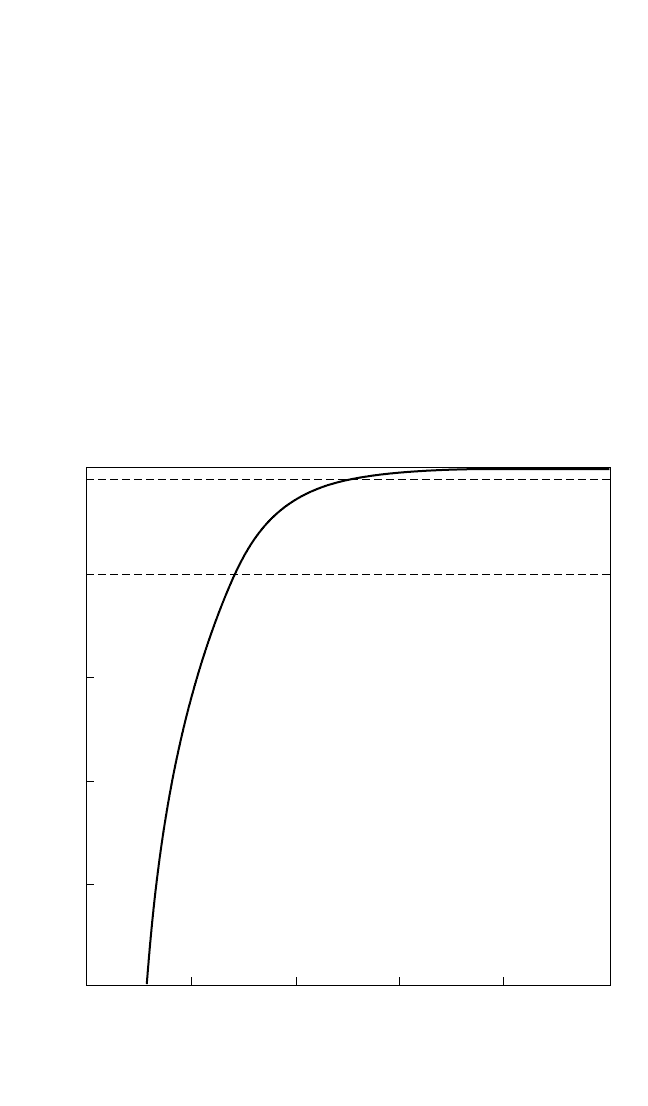
resulting database should describe, to the desired level of confidence, the failure
mode, the data scatter, and the response variability of a composite structure. These
data along with full-scale test articles can be used in the argument to justify qualifi-
cation.
Out-of-plane failure modes can complicate the generation of the database. Well-
proven and reliable transverse test methods are few. The typically high data scatter
makes higher numbers of tests desirable. In addition, the increased environmental
sensitivity in the thickness direction can cause failure mode changes, negating the
ability to pool data and possibly resulting in competing failure modes.Thus, a design
whose structural capability is limited by transverse strength can lead to increased
testing requirements and qualification difficulties.
The static strength of a composite structure is typically demonstrated by a test to
the design ultimate load (DUL), which is 1.5 times the maximum operating load, that
is, the design limit load (DLL). Figure 35.10 shows the reliability achieved for a sin-
gle static ultimate test to 150 percent of the DLL for values of the static strength
shape parameter from 0 to 25. For fiber-dominated failure with α
s
values near 20,
such a test would demonstrate an A-basis value, which is defined as the value above
which at least 99 percent of the population is expected to fall, with a confidence of
95 percent (a statistical tolerance limit as detailed in Chap. 20). However, for matrix-
ENGINEERING PROPERTIES OF COMPOSITES 35.19
0.9
95% CONFIDENCE RELIABILITY (R)
0.8
0.7
0.6
0.5
5010152025
STATIC STRENGTH SHAPE PARAMETER (α
s
)
A-BASIS ALLOWABLE
B-BASIS ALLOWABLE
1.0
FIGURE 35.10 Plot of the 95 percent confidence reliability against the static strength
shape parameter for a single full-scale static test to 150 percent of the design limit load.
8434_Harris_35_b.qxd 09/20/2001 12:29 PM Page 35.19
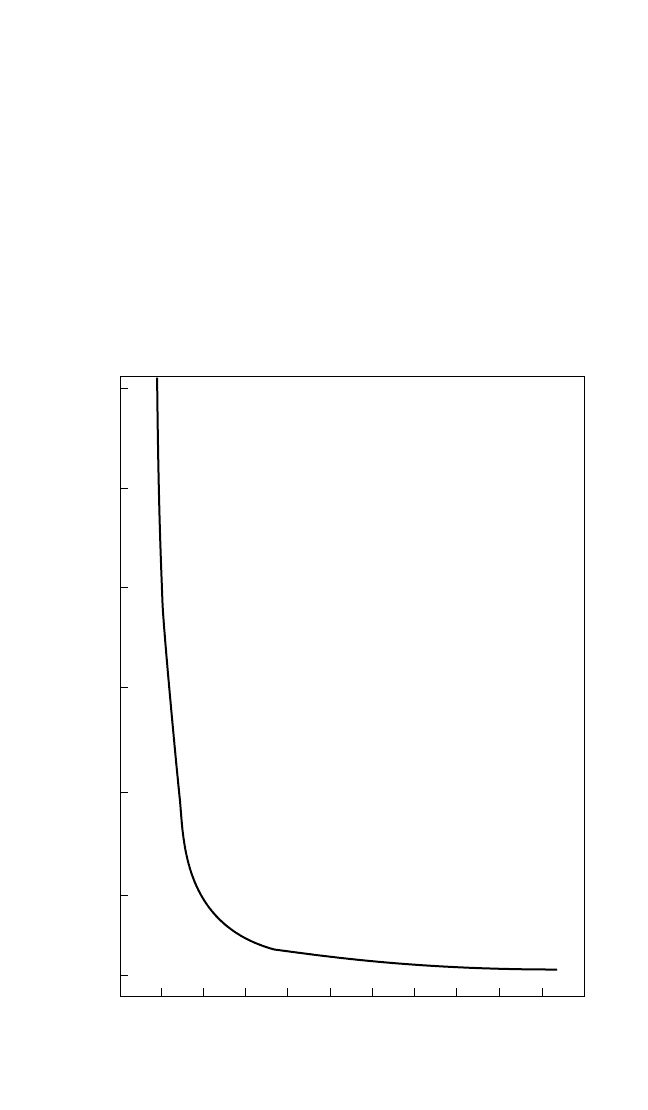
dominated failure modes, with α
s
ranging from 5 to 10, a test to 150 percent of the
DLL would not demonstrate an A-basis value. Two options are available to increase
the demonstrated reliability, namely, (a) increasing the number of test specimens, or
(b) increasing the load level. The most effective choice is to increase the load level
beyond 150 percent of the DLL, whereas increasing the number of test specimens
yields little benefit and is expensive.
The two most applicable methods of statistical qualification approaches for
fatigue are the life factor (also known as the scatter factor) and the load enhancement
factor. The life factor approach relies on a knowledge of the fatigue life scatter fac-
tor from the development test program and full-scale test or tests. The factor gives
the number of lives that must be demonstrated in tests to yield a given level of reli-
ability at the end of one life. A plot of life factor N
F
against the fatigue life shape
parameter α
L
is given in Fig. 35.11 for a typical scenario. A single full-scale test to
demonstrate the reliability of the B-basis value, defined as that value above which at
35.20 CHAPTER THIRTY-FIVE
20
LIFE FACTOR N
F
15
10
5
1
10
FATIGUE LIFE SHAPE PARAMETER α
L
30
25
2 3 4 5 6 7 8 9 10
FIGURE 35.11 Plot of the life factor required to demonstrate the reliability of
the B-basis results at the end of one life against the fatigue life shape parameter
using a single full-scale test article.
8434_Harris_35_b.qxd 09/20/2001 12:29 PM Page 35.20
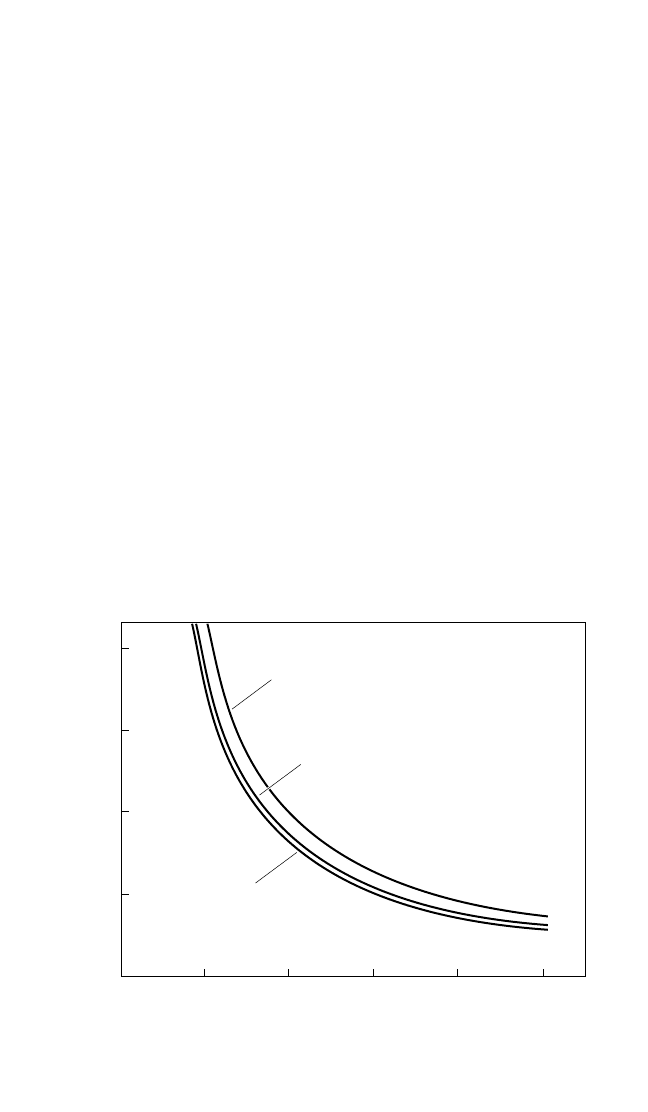
least 90 percent of the population is expected to fall, with a confidence of 95 percent
at the end of one life, is to be conducted. The curve shows that as the shape parame-
ter approaches 1.0, the number of lives rapidly becomes excessive. Such is the case
of an in-plane fatigue failure (α
L
= 1.25). Although few data for transverse fatigue
are available, other than perhaps for bonded parts, it is reasonable to assume that the
value of the shape parameter will be the same or less. Hence, it is apparent that the
life factor approach is not acceptable for the certification of composites, especially
where out-of-plane failure modes are dominant.
An alternative approach to life certification is the load enhancement factor,
wherein the loads are increased during the fatigue test to demonstrate the desired
level of reliability. Figure 35.12 illustrates the effect of the fatigue life shape param-
eter α
L
and the residual-strength shape parameter α
R
on the load enhancement fac-
tor F required to demonstrate B-basis reliability for one life using a single full-scale
fatigue test to one lifetime. It is obvious that the required factor does not change sig-
nificantly for fatigue life shape parameters in the range of 5 to 10. However, as the
shape parameter approaches 1.0, as is the case for composites, the required load
enhancement factor increases noticeably, especially for small values of the residual-
strength shape parameter. This curve illustrates well the potential problems that
may arise from dominant out-of-plane failure modes. Such failure modes tend to
have low values of α
L
(near 1.0) and also low values of α
R
(in the range from 5.0 to
10.0).These values would make the required load enhancement factors prohibitively
large. It is evident that for failure modes that exhibit a high degree of static and
fatigue scatter, the life factor and load enhancement factor approaches can result in
impossible test requirements. A combined approach can be achieved through the
manipulation of the functional expressions. The resulting method allows some lati-
tude in balancing the test duration and the load enhancement factor to demonstrate
a desired level of reliability.
ENGINEERING PROPERTIES OF COMPOSITES 35.21
LOAD ENHANCEMENT FACTOR F
1.6
1.4
1.0
0
RESIDUAL STRENGTH SHAPE PARAMETER α
R
1.8
α
L
= 1
α
L
= 5
α
L
= 10
1.2
5 10 15 20 25
FIGURE 35.12 Plot of the load enhancement factor required to demonstrate
the reliability of the B-basis results at the end of one life against the residual-
strength shape parameter for three values of fatigue life shape parameter using a
single fatigue test to one lifetime.
8434_Harris_35_b.qxd 09/20/2001 12:29 PM Page 35.21

Figure 35.13 gives the curves of load enhancement factor against life factor for
the cases of fiber- and matrix-dominated failures. Typical values for the fatigue life
and residual-strength shape parameter were employed. The curves show the possi-
ble combinations of life factor (or test duration) and load enhancement factor to
demonstrate the B-basis reliability at the end of one lifetime using a single full-scale
fatigue test article. The curve for fiber-dominated failure modes exhibits quite rea-
sonable values of life factor and load enhancement factor. For test durations ranging
from 1 to 5 lifetimes, the load enhancement factor ranges from 1.18 down to 1.06.
However, the test requirements for matrix-dominated failure are more severe. Over
the range of life factor from 1 to 5, the load enhancement factor ranges from 1.4
down to 1.19. An environmental compensation factor would further complicate the
test of a matrix-dominated failure. Such a factor must be combined with the load
level. As is well known in composites, the adverse effects of environment on matrix
properties are much more severe than on fiber-dominated properties, and the result-
ing factor may be significant.
Further illustration of the problems induced by a matrix-dominated failure is
possible by assuming a limit exists on the load enhancement factor. Such limits may
exist because of failure mode transitions at higher load levels. For instance, assuming
a load enhancement factor of 1.2 is the maximum allowable value, it is obvious that
a successful one-lifetime test for a fiber-dominated failure will demonstrate the reli-
35.22 CHAPTER THIRTY-FIVE
LOAD ENHANCEMENT FACTOR
1.6
1.4
1.0
0
LIFE FACTOR
2.0
1.8
FIBER-DOMINATED FAILURE (
α
L
= 1.25,
α
R
= 20)
1.2
51015202530
MATRIX-DOMINATED FAILURE (
α
L
= 1.0,
α
R
= 10)
FIGURE 35.13 Plot of possible combinations of load enhancement factor and life factor neces-
sary to demonstrate the reliability of the B-basis results at the end of one lifetime using a single full-
scale test article for matrix- and fiber-dominated failure modes.
8434_Harris_35_b.qxd 09/20/2001 12:29 PM Page 35.22

ability better than a B-basis test. For matrix-dominated failure, the same reliability
would require a test duration of about 4.5 lives.
Two important aspects of the statistical qualification methodology are the gener-
ation of an adequate database and the proper execution of a full-scale demonstration
test. The development test program must be conducted in a “building block”
approach that produces confident knowledge of the material shape parameters, envi-
ronmental effects, failure modes, and response variability. Perhaps the most impor-
tant result should be the ability to predict the failure mode and know the scatter
associated with it. Structures that exhibit transverse failures, which can result in com-
peting modes and a high degree of scatter, may render the application of this fatigue
methodology impractical. This result has been illustrated by the effect of shape
parameters on both the static and fatigue test requirements.The requirements clearly
show that a well-designed structure that exhibits fiber-dominated failure modes will
be more easily qualified than one constrained by matrix-dominated effects.
FAIL SAFE/DAMAGE TOLERANCE METHOD
The damage tolerance philosophy assumes that the largest undetectable flaw exists
at the most critical location in the structure, and the structural integrity is main-
tained throughout the flaw growth until detected by periodic inspection.
12
In this
approach, the damage tolerance capability covering both the flaw growth potential
and the residual strength is verified by both analysis and test. Analyses would
assume the presence of flaw damage placed at the most unfavorable location and
orientation with respect to applied loads and material properties. The assessment of
each component should include areas of high strain, strain concentration, a mini-
mum margin of safety, a major load path, damage-prone areas, and special inspec-
tion areas. The structure selected as critical by this review should be considered for
inclusion in the experimental and test validation of the damage tolerance proce-
dures. Those structural areas identified as critical after the analytical and experi-
mental screening should form the basis for the subcomponent and full-scale
component validation test program. Test data on the coupon, element, detail sub-
component, and full-scale component level, whichever is applicable, should be
developed or be available to (a) verify the capability of the analysis procedure to
predict damage growth/no growth and residual strength, (b) determine the effects of
environmental factors, and (c) determine the effects of repeated loads. Flaws and
damage will be assumed to exist initially in the structure as a result of the manufac-
turing process, or to occur at the most adverse time after entry into service.
A decision to employ proof testing must take the following factors into consider-
ation:
1. The loading that is applied must accurately simulate the peak stresses and stress
distributions in the area being evaluated.
2. The effect of the proof loading on other areas of the structure must be thoroughly
evaluated.
3. Local effects must be taken into account in determining both the maximum possi-
ble initial flaw/damage size after testing and the subsequent flaw/damage growth.
The most probable life-limiting failure experienced in composite structure, particu-
larly in nonplanar structures where interlaminar stresses are present, is delamina-
tion growth. Potential initiation sites are free edges, bolt-holes, and ply terminations
(see Fig. 35.2), in addition to existing manufacturing defects and subsequent impact
ENGINEERING PROPERTIES OF COMPOSITES 35.23
8434_Harris_35_b.qxd 09/20/2001 12:29 PM Page 35.23

damage. Hence, an analysis technique for the evaluation of growth/no growth of
delaminations is an essential tool for the evaluation of the damage tolerance of com-
posite structures. A numerical method is available through the use of finite element
analysis (see Chap. 28, Part II) and the crack closure integral technique from frac-
ture mechanics.
13
Prerequisites for an evaluation are as follows:
1. A structural analysis made in sufficient detail to indicate the locations where the
critical interlaminar stresses exist.
2. Experimentally based critical interlaminar strain energy release rates G
ic
, G
Iic
,
and a subcritical growth law, that is, da/dN, where da/dN is the rate of change of
the crack length or damage zone size a with the number of cycles N, against ∆G
for each mode (see Chap. 34).
3. A mixed mode I/mode II fracture criterion.
The test specimens used to generate the required mode I and mode II fracture
toughness parameters are described in detail in Ref. 14. The application of this
approach requires a significant analysis and test effort to evaluate hot spots within
the structure and to generate the necessary fracture toughness data. One limita-
tion is the absence of a reliable mixed-mode fracture criterion, and consequently
this method is not considered sufficiently mature to warrant a recommendation
for wide general application, particularly for developmental composite hardware
evaluations.
THE WEAROUT MODEL
Wearout is defined as the deterioration of a composite structure to the point where
it can no longer fulfill its intended purpose. The wearout methodology was devel-
oped in the early 1970s and is comprehensively summarized in Ref. 15. The essential
features are portrayed in Fig. 35.14. This methodology was previously used by the
military aircraft command for the certification of several composite aircraft compo-
nents. In essence, the wearout approach recognizes the probability of progressive
structural deterioration of a composite structure. The approach utilizes the develop-
ment test data on the static strength and the residual strength, after a specified
period of use, in conjunction with proof testing of all product hardware items to
characterize this deterioration and protect the structure against premature failures.
It has become evident that the residual stiffness is an indicator of the extent of the
structural deterioration and can be an important performance parameter with
regard to the natural frequencies of oscillation of the aerodynamic surfaces. Thus, in
some instances, it may be prudent to incorporate a residual-stiffness requirement in
an adopted methodology to evaluate the tolerance of the structure to component
stiffness degradation.
The difficulties in the implementation of the methodology include the determi-
nation of the critical load conditions to be applied for static and residual strength
and stiffness testing and for the proof load specification. Similar difficulties would
arise in the case of all candidate methodologies considered here, and indeed empha-
size the importance of a representative structural analysis. However, the advantage
of the wearout approach for advanced composite hardware development projects
resides in the ability to assign gates for safe flight testing as the flight envelope is
progressively expanded.
Since the era of the initial development and interest in the wearout approach,
there appears to have been minimal development or usage. Nevertheless, the poten-
35.24 CHAPTER THIRTY-FIVE
8434_Harris_35_b.qxd 09/20/2001 12:29 PM Page 35.24
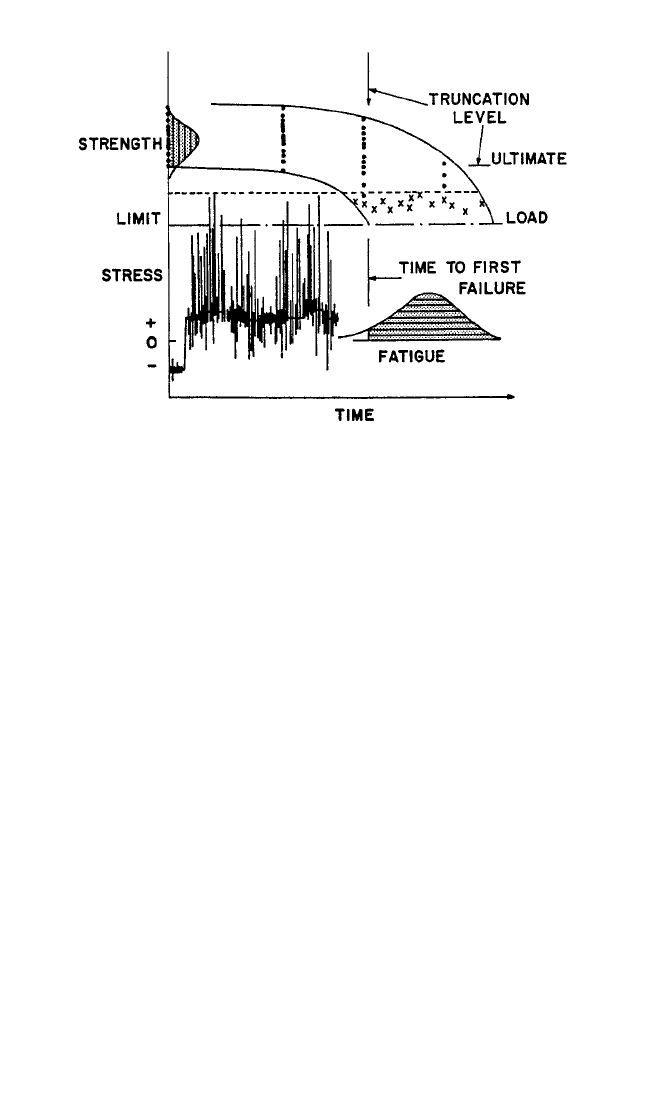
tial motivation for a methodology of this type calls for a brief review of the physical
and theoretical basis for the important concepts. Further detail can be found in Refs.
15 and 16.
By combining several basic assumptions regarding the behavior of a composite
structure under load with basic Weibull statistics, a kinetic fracture model can be
derived. This model serves to assist in predicting the fatigue wearout behavior of
composite structures. The first assumption concerns the growth rate of an inherent
or real material flaw, da/dt, which is deemed to be proportional to the strain energy
release rate G of the material system raised to some power r, where r is to be deter-
mined experimentally. Thus
da/dt ∝ G
r
(35.4)
where a is the flaw length. As the cyclic load, F(t), is applied to the flawed body, the
internally stored strain energy will occasionally exceed the critical level required to
overcome the local resistance of the material to flaw growth or damage accumula-
tion, and flaw or damage growth will occur. Impediments to further development
have been related to those cited in Chap. 34, as it pertained to the fracture mechan-
ics method for metals, i.e., the need for further data to define the growth rate and/or
threshold level below which the damage area does not grow. One important wearout
parameter r is defined as the slope of the da/dN curve, or may be derived from the
S-N curve for the failure/damage mode in question.
Various relationships have been proposed
15
relating the initial Weibull static
shape parameter, α
0
, and the fatigue life shape parameter, α
f
, both of which tend to
be a function of the damage size exponent alone. Specifically, available relationships
are given by
α
0
= 2r + 1 and α
f
= (35.5)
α
0
2(r − 1)
ENGINEERING PROPERTIES OF COMPOSITES 35.25
FIGURE 35.14 Essential features of the “wearout model” relating static
failure, load history, and fatigue failure.
8434_Harris_35_b.qxd 09/20/2001 12:29 PM Page 35.25

Postulating that the composite system will lose strength at a uniform rate with
respect to a logarithmic scale of cycles or time, then from the specific fatigue curve
expressed as
NF
γ
b
= B
N
or tF
γ
b
= B
t
(35.6)
the slope of the fatigue curve is given by γ=−1/2. In Ref. 16, a compilation of data on
damage growth rate exponents from a broad range of literature items, including var-
ious types of polymer composite systems and composite bonded structures, were
found to range between 4.3 and 6.6.
DAMPING CHARACTERIZATION
The major sources of damping in polymer matrix composites (PMCs) are associated
with the visco-elastic or microplastic phenomena of the polymer matrix constituent
and, to some degree for some composite systems, with weak fiber-matrix interfaces
to microslip mechanisms. Other sources of damping, such as matrix microcracking
and delamination resulting from poor fabrication conditions or service damage, can
also create increased damping in certain cases. Very little or no damping is con-
tributed by the fiber-reinforcement constituent with the possible exception of
aramid, i.e., Kevlar, fibers. Environmental factors, such as temperature, moisture,
and frequency, on the other hand, can have a significant effect on damping.
Two-phase materials therefore tend to derive any damping from the polymer
matrix phase in a large majority of composite systems. Consequently, matrix-
influenced deformations, such as the interlaminar shear and tension components,
are the significant contributors. For the basic unidirectional composite, some closed-
form predictive methods are available, but generally the micromechanics theories
have been found to be unreliable for damping determinations, although reasonable
for modulus predictions. Structural imperfections at the constituent level are con-
sidered to be the main contributors to this situation.
As mentioned earlier, micromechanics-based theories are available to give some
indication of the effects of fiber volume content on damping parameters for unidi-
rectional materials. One example based on conventional visco-elasticity assumption
was formulated in Ref. 11 for the case of longitudinal shear deformation. For this
case the specific damping capacity (SDC), ψ
12
, for longitudinal shear can be
expressed
17
as
ψ
12
= (35.7)
where ψ
m
= the SDC for the matrix
G = the ratio of fiber shear modulus to that of the matrix
V
f
= the fiber volume fraction
For the condition of flexural vibration of composite beams, the damping due to
transverse shear effects that are highly matrix-dominated exhibit up to two orders of
magnitude greater damping than pure axial, fiber-direction effects. Specific data,
adapted from Ref. 18, on the SDC for the flexural vibration of unidirectional beams,
ψ
m
(1 − V
f
)[(G + 1)
2
+ V
f
(G − 1)
2
]
[G(1 − V
f
) + (1 − V
f
)][G(1 − V
f
) + (1 + V
f
)]
35.26 CHAPTER THIRTY-FIVE
8434_Harris_35_b.qxd 09/20/2001 12:29 PM Page 35.26
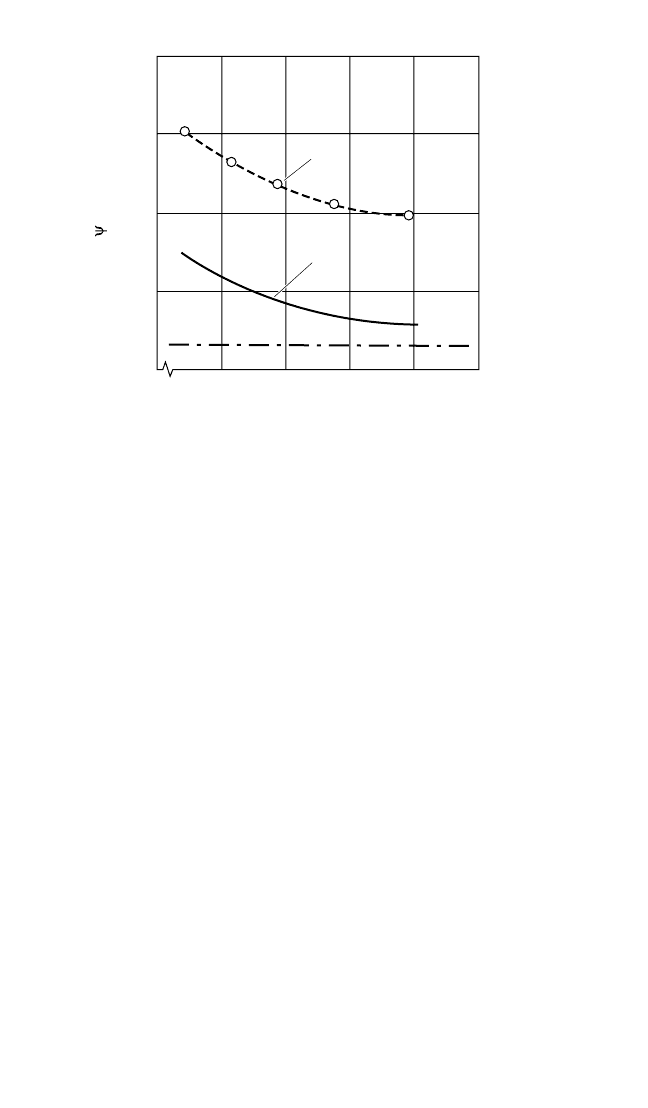
over a range of aspect ratios (length /thickness h), are compared to theoretical pre-
dictions in Fig. 35.15. Here the steady increase in damping for progressively lower
beam aspect ratios is clearly due to the shear deformation which indicates a much
stronger effect on damping than on the flexural modulus. The discrepancies in the
theoretically predicted SDC in Fig. 35.15 is generally attributed again to imperfec-
tions in the composite at the constituent level.
The damping trends for the other matrix-influenced deformational mode of
transverse tension (at 90° to the fiber direction) in a unidirectional composite is
illustrated in Fig. 35.16 for an E-glass fiber-reinforced epoxy over a wide range of
fiber volume fractions V
f
. Substantial damping can also occur in the deformation of
an off-axis, unbalanced lamina or laminate, due to shear-induced deformation cre-
ated by coupling under tension, compression, or flexural loading directed at an angle
to the fiber direction. In Ref. 19, good correlation between the theoretical prediction
and experimental measurements is demonstrated for a complete range of fiber ori-
entations from 0° to 90° (see Fig. 35.17). Based on the flexural vibration of a high-
modulus carbon-fiber/epoxy matrix system with V
f
= 0.5, Fig. 35.17 compares both
the flexural modulus and SDC. The latter damping parameter was predicted using
the approximate relationship
ψ
θ
= E
x
sin
4
θ+ sin
2
θ cos
2
θ
(35.8)
where x = the axial direction of the beam
θ=the angle between the fiber direction and the axis of the beam
E
2
, ψ
2
= the elastic modulus and SDC, respectively, in the transverse direc-
tion of the fiber
G
12
, ψ
12
= the shear modulus and shear-induced SDC, respectively, referred
to directions parallel and perpendicular to the fibers
ψ
12
G
12
ψ
2
E
2
ENGINEERING PROPERTIES OF COMPOSITES 35.27
L
, %
0.5
0807060 10090
BEAM ASPECT RATIO, l/h
1.0
0.75
0.5
0.25
THEORETICAL SDC
MEASURED SDC
THEORETICAL RULE OF MIXTURES SDC
THEORETICAL SDC
MEASURED SDC
THEORETICAL RULE OF MIXTURES SDC
FIGURE 35.15 Variation of flexural damping with aspect
ratio for high-modulus carbon fiber in DX209 epoxy resin V
f
=
0.5, SDC, shear damping contribution.
8434_Harris_35_b.qxd 09/20/2001 12:29 PM Page 35.27
